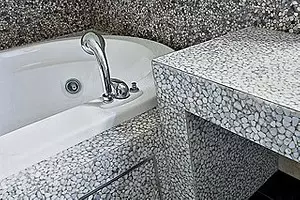
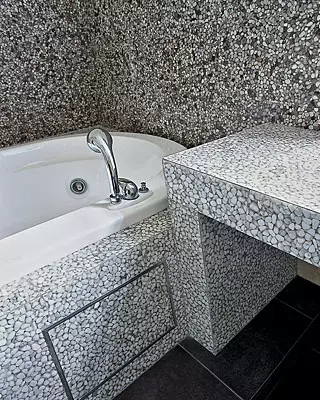
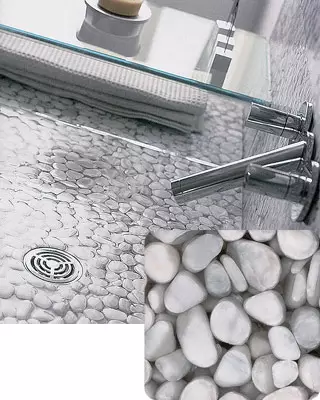
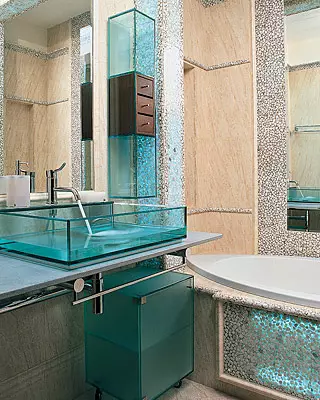
Photo M.Stepanov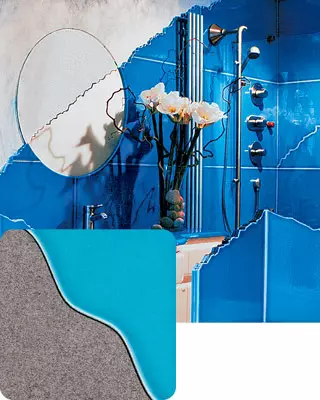
Glazed volcanic lava Pyrolave combines all the advantages of natural stone and properties attached to this material
Water from the bathrooms of the house, which we spend speech, for finishing walls of the room, the screen of the bath and countertops are used Riverstone material from Effepi Marmi (Italy). His name (translated from the English- River Stone) speaks for itself: This is an agglomerate based on an optically transparent resin and rolled marble and river pebbles. Pebbles can have several sizes (Medium, Small and Large, depending on the thickness of the tile) and colors: from the White Bianca Carrara to the Emerald Verde Alpi.
From Riverstone produce a large range of sizes: 200200, 300300, 400400, 600400, 600600 mm, as well as products with a maximum thickness of 30mm and a format to 1830830mm. The cost of 1m2 tiles of 3030mm with a thickness of 14 mm - from 7890 rubles.
Riverstone gives a wide scope for designer experiments. One of the main features of the material is its light-permeability allows you to create the illusion of pebbles with water with a different kind of highlightened. It is not by chance that it is in premises related to water topics - bathrooms and pools, finishing with Riverstone looks most interesting and organic.
The material is made in two series. The first consists of white marble with transparent and tinted resin (colorless blue, light green, pink, yellow idr.). The second is made of transparent resin and pebbles of various shades.
In addition to decorative advantages, the material also has a number of other advantages. Used in the manufacture of Riverstone resin is durable and resistant to mechanical damage and surface abrasion, so the tile can be used not only when cladding the walls, but also for finishing the floor (including the equipped heating system). Due to the slightly uneven surface and the special composition of the resin, the material has anti-slip properties, which is especially important for floors in rooms with high humidity.
Resin has a low adsorption coefficient - 0.42%, which makes Riverstone almost immune to moisture. However, if some coloring substance, acid, oil, coffee, cola, lemon juice fall on the surface of the tile, then it is necessary to rub a wet cloth immediately. In order to preserve the attractive appearance of the products for a long time, they should be periodically handled with protective waxes created specifically for marble surfaces. The prerequisite for finishing Riverstone is a clear maintenance of seams between the plates. So, for products up to 400400mm, the minimum recommended width of the seam is from 1 to 1.5 mm, for the tiles of large formats - 2mm. For cutting modules, diamond discs and blades should be used, and for edible processing, the same tools that are used when working with plates from natural marble.
Another elite and fashionable finishing material, which today is increasingly used in the bathrooms, - Born Pyrlave volcano. Raw materials for Ryrolave plates are produced in the vicinity of the French town Volwick. The local lava is 85% composed of silicon, which provides excellent adhesion finishing glaze, having almost the same chemical composition. Lava's boulders are cut on a blank with a thickness of 8 to 100mm, depending on the destination of the final product. From the billets make plates of the desired dimensions, put them in the chamber for applying the glaze, and then to the firing furnace, which (depending on the volume of the plate and the desired color) goes at a temperature of from 960 to 1500C. This or that color is obtained by introducing metal oxides into the glaze.
Natural stone from volcanic lava is absolutely immune to temperature drops and exposure to sunlight, to acids, fats and alkali. The exact dimensions and large formats of the plates allow you to lay them almost without seams, creating holistic compositions. Ryrolave care does not require special detergents, it is enough to wipe it with a soapy sponge. Cost of products - 34300rub. / M2.
